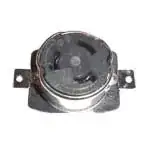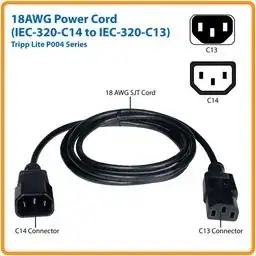We have a cabinet of servers and other hardware (switches, firewalls, etc) that all are currently running on 120v. I've confirmed that the power supply for all of our devices support both 120v and 240v and I understand we'll need to get a 240v PDU. My question is, if we switch from 120 to 240, what power cables do I need to purchase that will plug in to the PDU on one end, and into the server power supplies on the other? For reference, we're using mostly Dell Poweredge servers.
3 Answers
For 208 or 240v in the US and Canada the standard configuration:
From wall to PDU - L6-30R or L6-50R


If you have a UPS, it should use the same connectors both in and out.
The PDU may branch to smaller "extension" units using C19/C20 (Female Plug/Male Receptacle).

Whatever connects to the servers and equipment would use standard C13/C14 (Female Plug/ Male Receptacle) at both ends, which is the same connector as the power supply on those devices. You'd use cords like this one to plug in the servers:

-
L6-30R is what I typically use. If you are fortunate enough to have a full height and extra depth cabinet you can easily fit 2 full length PDUs side by side down the vertical side channel, with each plugged into the UPS or even separate UPS on separate circuits if you are paranoid. Another thing to note though...don't expect to give up your 120v UPS and PDU. You'll inevitably end up with peripherals, kvm, or something that still requires 120v and running an orange extension cord just messes up the pretty new cabinet design. Oh and get ready for a drop in your electric bill... – TheCleaner Aug 13 '14 at 14:16
As a UK user who only uses 220/240v I'm not aware of what plugs are used in the US but am very familar with the C13/C14 and C19/C20 and I would just like to add:
It is important that you are aware of the limitations of the C13/C14 connectors and when not to use them.
I have seen PDUs that only use C13 lead and high capacity PSUs that care connected to a C13 downstream.
C13 leads are only required to be fitted with wires of 6Amp capacity, and the physical plug is not designed to be used with more than 10Amps no matter what cables and fuses are used. Many C14 connectors will display a maximum current (ampacity) lower than 10 Amps. The C13 specification also only requires it to be able to handle 70 Degrees Celsius. So the 6 amp wires in some cases melt the socket if misused.
C19 on the other hand are designed with 16A in mind however check your cables for their capacity, it is marked if lower than 15A. Also pay attention to C20 sockets at most I see are only rated to 15A or 13A
- 838
- 3
- 16
- 47
-
1+1 This is even more important in 120v systems where the amp draw is double. All the equipment I have has ratings of 5A for C13/C14, and 15A for C19/C20 - basically consistent with what you're saying. Out of curiosity, what do you plug into the wall for ~30A or ~50A? – Chris S Aug 11 '14 at 15:52
-
As a best practive we use the blue 309 spec http://en.wikipedia.org/wiki/IEC_60309 however older infrastructure still uses British Standards BS 196 connectors ( a throwback to our imperialist past where we dictated most of these standards) and Lewdens http://en.wikipedia.org/wiki/Industrial_and_multiphase_power_plugs_and_sockets#UK:_Lewden_plugs although 95% of the time its the IEC standard, you buy these to spec – ZZ9 Aug 11 '14 at 16:15
Your equipment is using C13/5-15P power cords plugging into NEMA 5-15R receptacles on your existing 120v PDU. The 240v PDU is going to have IEC C14 receptacles, so you'll need IEC C13 to C14 power cables.
- 108,377
- 6
- 80
- 171